
 China Tours
China Tours Tibet Tours
Tibet Tours China Theme Tours
China Theme Tours Off The Beaten Track
Off The Beaten Track Yangtze Cruises
Yangtze Cruises China Trip Planner
China Trip Planner Travel Agents
Travel Agents


We had a wonderful time in Tibet. We have learned a lot about this unique destination because of the wonderful guide Degyi who is so knowledge and always available towards our tours. We stayed at the Shangri-La Hotel Lhasa, and we would never imagine a Tibet travel could be so nice and amazing without the help of Degyi.
Also, thanks a lot to our Tibetan driver Mr.Wongdun for his safe driving and a good sense of service along the way.
We shall return Tibet in the near future!
P.B. and A. A - Europe
Tibet Travel
June 2018 (Private Tibet Journey from Kathmandu)

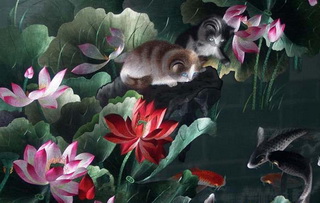 Embroidery, Stone Carvings, Paper-cut, Folding Fan, Clay Figurines, Chinese Porcelain, Chinese Cloisonne, Chinese Lacquer ware, Chinese Silk.
Embroidery, Stone Carvings, Paper-cut, Folding Fan, Clay Figurines, Chinese Porcelain, Chinese Cloisonne, Chinese Lacquer ware, Chinese Silk.Embroidery
Embroidery is traditional Chinese handicraft art. which is divided into the Suzhou, Sichuan, Guangdong and Hunan schools. Suzhou embroidery is celebrated for its sophisticated stitching, vivid pictures, beautiful patterns and elegant colors. Human Embroidery emphasizes vivid patterns. Guangdong and Sichuan embroideries feature popular motifs, such as a peacock spreading its tail, a magpie on the branch of a plum tree, pines and cranes as symbols of long life, two dragons playing with a ball, and a phoenix and Peony. The embroidery items have varied themes: Some are romantic and exaggerative, others reflect the reality, or are vivid and true to life. Both are of practical and ornamental uses.
Stone Carvings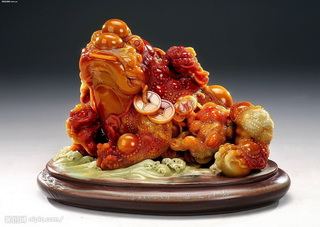
The stone carvings of the Hui'an area of Fujian Province have a history of over 1,600 years. Over the centuries, they have developed into over 250 varieties in six categories. Hui'an stonemasons created such treasures as the East and West pagodas in Quanzhou, the peristyles of the Dragon Hill Temple in Taipei, the stone lion at the Sun Yat-sen Mausoleum in Nanjing, the statue of Zheng Chenggong on Drumming Wave Islet in Xiamen, and the peristyles of the Great Hall of the People in Beijing. The stone carvings by Hui'an have a ready market at home and abroad.
Paper-cut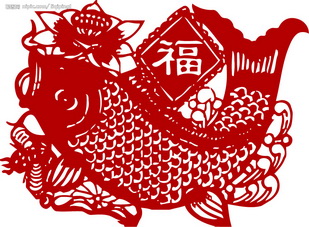
The paper cuts of Shanxi feature a wide variety of themes, including flowers, human figures, animals, legends, folk tales all stories from operatic works, and showing a bold and unrestrained style, simple and unsophisticated presentation and strong local characteristics. There are two types - colored and monochrome.
Folding Fan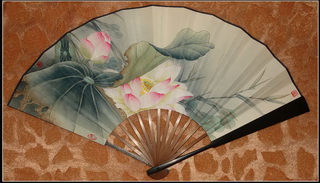
The folding fan is a folk handicraft for use in cooling oneself in summer, and is also used as a decoration or a stage prop in traditional Chinese operas. Due to their fine workmanship, the folding fans produced in Rongchang, Chongqing, are prized both at home and abroad. Since ancient times, Rongchang folding fans have been sold well throughout the country, as well as to India, Myanmar and other countries.
Clay Figurines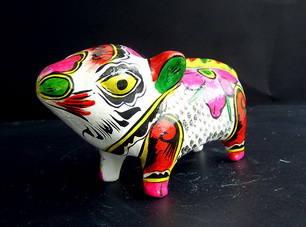
The Huishan clay figurines made in Wuxi, Jiangsu Province emerged in the Ming Dynasty and have a history of over 400 years. Thanks to their unique art style, these colored figurines have been well received by the Chinese people throughout the country and have been sold to 50 countries and regions. Masters of the art have given demonstrations in Japan, the U. S., Australia and other counties. Hence Huishan clay figurines display the best color modeling art in the East.
China Porcelain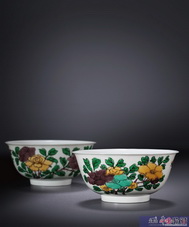
Porcelain is perhaps the greatest invention of the Chinese people. During the Neolithic period 8,000 years ago, the Chinese began making earthenware with clay. It first appeared by the Shang Dynasty (16th~11th century B.C.) known as "protoporcelain" and matured in the Han Dynasty. The celadon wares from Shaoxing, Zhejiang Province and the white porcelain from Neiqiu, Hebei Province were famous throughout the country. Porcelain making reached its peak during the Ming (1368~1644A.D.) and Qing (1644~1911A.D) Dynasties. Jingdezhen in Jiangxi province dominated porcelain production and garnered fame as the national center. Its products had a special appeal. Superb porcelain such as qinghua (blue and white), jihong (rainbow), doucai(blue and white with a red, yellow, green and purple overglaze),fencai (famille rose),etc, were without equal anywhere in the world. Today, in addition to inheriting traditional methods, Chinese ceramists are developing many new techniques. The wares of Jingdezhen, the underglazed wares of Liling, the gold-outlined wares of Tangshan, the crystalline-glazed wares of Zibo win acclaim from porcelain connoisseurs at home and abroad.
Chinese Cloisonne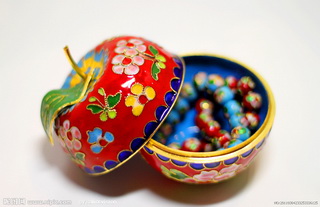
Cloisonne is typically called the 'Blue of Jingtai' as blue is the dominant color adopted for enameling and Cloisonne became prevalent during the reign of Jingtai (1450-1456) in the Ming Dynasty. The making of Cloisonne involves quite elaborate and complicated processes: base-hammering, soldering, enamel-filling, enamel firing, polishing and gilding. The manufacture of cloisonne ware requires an elaborate and complicated process, namely, base-hammering, copper-wires curving, soldering, enamel-filling, enamel-firing, polishing, gilding, etc. They are beautiful and elegant in moulding, splendid and graceful in design and dazzling and brilliant in colors of light blue, dark blue, red, cream, yellow, light gray, green, brown, black, white, etc. Varieties available include vases, jars, bowls, plates, ash-trays, smoking or seasoning sets and so on.
Chinese Lacquer ware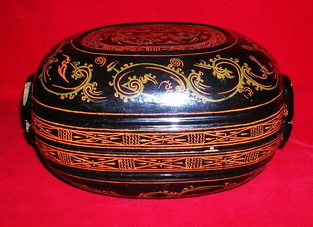
Lacquer ware from Beijing and Yangzhou originated in the Han Dynasty and has been handed down and developed from generation to generation. Multifarious in kind and exquisite in workmanship, it is characterized by elegant modelling, beautiful figuration, and lustrous color. The complicated manufacturing process includes mould-casting, internal enamel coating through burning, background-coating, lacquer-application, design-tracing, engraving, and burnishing. Copper or other materials are used for making the body in which tens of layers of lacquer are coated, and sometimes as many as two hundred layers, as the case requires. Then on the lacquer layers, attractive motifs are carved against a background of the floral designs by artisans` cunning knife. Some are inlaid with ivory and precious stones to make beautiful works of art. Some are for practical use--garden stools, screens, chests, jewelry boxes, smoking sets, jars, flower containers, etc. Most of them are red in color; some go with black, yellow or green lacquer-layers to match.
Chinese Silk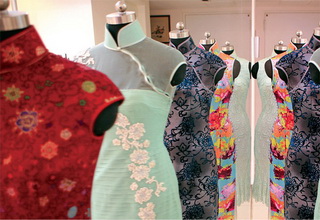
Silk is one of the best materials for clothing that has hardly any match in the world. Reputed to be the queen of fabrics it is light, lustrous, and durable. Also it has the advantages of being soft to the touch, resistant to heat, and breathing very well. All these features make it an ideal fiber for beautiful satins, charming brocade and attractive dresses. If one goes to a traditional opera in China. One will find people from well-to-dl families in silk dresses, which are believed to be commensurate with their social status. China is the first producer of silk in the world: silk production was started in the country circa 4,500 years ago. And today, centers of silk production are stringed along rivers in south China, in Suzhou and Hangzhou, for instance, in the lower reaches of the Yangtze River, in Fushan in south china. And in Nanchong in south west china. And many other areas as well, where silk-worms are bred.
During the Zhou Dynasty (11th century-256BC), a special administration was set up to manage sericulture (silkworm breeding) and silk production. The famous Silk Road to the Middle East and Europe started under Zhang Qian. Under imperial order, he started his diplomatic mission to the West from 138 BC to 126 BC. Gradually, sericulture and silk production techniques spread to other countries. Chinese silk was highly prized among the wealthy of the ancient Roman Empire. Today, Chinese silk still enjoys its reputation for high quality throughout the world.
The business of raising silkworms and unwinding cocoons is now known as silk culture or sericulture. It takes an average of 25-28 days for a silkworm, which is no bigger than an ant, to grow old enough to spin a cocoon. Next, farmers (usually female) will pick them up and place them one by one onto piles of straws. Then each silkworm, with its legs stretched out, will attach itself to the straw and begin to spin.
The next step is unwinding the cocoons, a process that is usually done by "reeling" women. The cocoons are heated to kill the pupae, which must be done at the right time; otherwise, the pupas are bound to turn into moths. (Moths make a hole in the cocoon, an event that makes reeling useless.) To unwind the cocoons, first they are put into a basin filled with hot water. Then the reeling women find the loose end of the cocoons, and then twist them. Afterwards, the women carry the cocoons to a small wheel for unwinding. At last, two workers measure them into a certain length and twist them into so-called "raw" silk, which then are dyed and woven into cloth. An interesting fact is that about 1,000 meters of can be unwound from one cocoon, while 111 cocoons are needed for a man'a tie, and 630 cocoons are needed for a woman's blouse.
The Making of Silk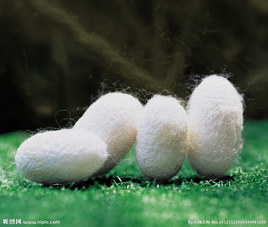
The making of silk generally refers to the process of dividing raw silk from cocoons into strands horizontally and vertically, before weaving them together into pieces of fabric. The actual manufacture processes of various silks vary, but can be generally categorized into two types: sheng zhi and shu zi. In the sheng zhi process, weavers weave the raw silk into fabrics first, and then scour (clean) and bleach the fabrics. This process, which has lower costs and a shorter process, is currently the major way of making silk. In the shu zhi method, weavers scour and bleach the longitude and latitude silks from cocoons first before actually weaving them. The woven products no longer need further processing and can be directly used. The method is usually used to produce advanced silk fabrics like brocade. Before the silk is woven, a lot preparations need to be done beforehand, like soaking the raw silk to soften the product. Meanwhile, as silk is very apt to absorb moisture, to make the silk damp-proof is very important before the weaving.
In terms of the silk pattern, the weaving methods can be generally divided into the common and jacquard methods. The former refers to the flat silk fabrics that have no weaved patterns, while the latter refers to the fabrics that are usually done by a jacquard loom (a loom that is mechanized to weave specific patterns). When the silk fabrics are ready, the next step is the dyeing process (which is crucial in the whole procedure of making colorful and beautiful silk). With the dyeing technologies, the raw silk can be turned into flawless silk with patterns and colors to peoples desire.
In ancient China, once the cloth had been weaved, embroidery was used to give the cloth its delicate, often brilliant patterns. The Four Renowned Embroideries of China were regional in their origin: Su embroidery originated from East Chinas Jiangsu Province; Yue embroidery originated from South Chinas Guangdong Province; Xiang embroidery originated from Central Chinas Hunan Province; and Shu embroidery originated from Southwest Chinas Sichuan Province.
The Silk Kingdom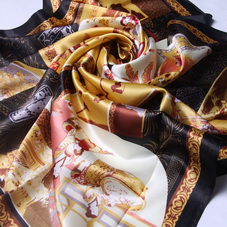
Silk, as a symbol of ancient Chinese culture, has not only weaved an excellent picture in the nations civilization history, but also has made indelible contributions for the advancement of human beings. For thousands of years, Chinese silk has been known for its superior quality, exquisite patterns, and rich cultural connotations.
Several thousand years ago, when the silk trade first reached Europe via the Silk Road, it brought with it not only gorgeous silk apparel and decorative items, but also the ancient and resplendent culture of the Far East. From then on, silk was regarded as the emissary and symbol of Eastern civilization. The earliest silk article discovered to date is approximately 4700 years old, unearthed from a tomb dating from Chinas Liangzhu Culture (c. 3300-2200 BC).
According to an ancient Chinese legend, the Silkworm Goddess appeared to the Yellow Emperor, the legendary ancestor of the Chinese people, after he had vanquished his adversary Chi You. She presented him with silk fibers spun from her own mouth as a sign of respect. The Yellow Emperor ordered the fibers woven into cloth and made into silk apparel, which he found exceedingly soft and comfortable.
Lei Zu, the Yellow Emperors wife, searched until she found some caterpillars capable of spinning silk fibers from their mouth. She raised these silkworms by feeding them mulberry leaves she picked herself. Later generations came to worship Lei Zu as the Silkworm Goddess, and the Yellow Emperor as the God of Weaving. Sericulture, including cultivating the mulberry plant, raising silkworms, and producing silk fabric, has been an essential form of labor in China throughout the millennia, as China is the birthplace of sericulture. Raising silkworms and reeling the silk from their cocoons was ancient Chinas greatest achievement in the use of natural fibers. As long ago as the Neolithic Age (c. 12,000-2000 BC), the Chinese ancestors had invented flat-weaving and figured-weaving techniques, and were tinting cloth using natural (red pigment) vermilion dye. With improvements in looming devices and printing and dyeing methods, more varieties of silk were developed and a comprehensive system of cloth dying evolved. China possessed the most advanced silk dying and weaving techniques of the ancient world.
China Trip Planner | Travel Agents | About Us | Why Us | Contact Us | How to Pay | How to Book - Terms & Conditions | Site Map
Copyright © 2010 - 2030 All Rights Reserved.


 0086-28-85711328
0086-28-85711328 0086-28-85546015
0086-28-85546015




